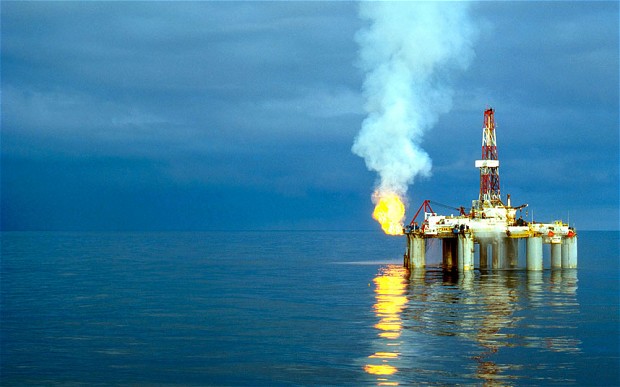-
Experts are warning oil rigs could soon be shutting down in the North Sea.
-
An Independent Scotland would have faced the brunt of oil price falls had they succeeded to separate from the UK in their ‘yes or no’ vote to separate.
-
Revenues from North Sea exposures would have dropped alarmingly in the current situation.
London: Scotland’s North Sea revenues would have slumped to one fifth of Holyrood’s preferred forecasts in its first year of independence if Scots had voted ‘Yes’ to separate from Great Britain in September, according to an Office for Budget Responsibility (OBR) simulation using current oil prices.
A news report in the British Financial Times says the OBR projections, which take into account a dramatically lower oil price than the one used in Scottish government forecasts, highlight how the nation has been saved from a crisis in its public finances by voting ‘No’.
Had Scotland voted ‘Yes’ to independence, it would now be looking at oil revenues of £1.25 billion (Dh7.18 billion) instead of £6.9 billion in 2016-17 — its first year as a new country — while facing a deficit of close to 6 per cent of national income, compared with a UK forecast of 2.1 per cent. Paul Johnson, director of the Institute for Fiscal Studies, said the OBR scenario highlighted “the uncertainty and volatility of oil prices and their impact on Scotland, which is far more dependent on oil revenues than the rest of the UK”.
North Sea revenues are already falling to negligible levels, after Brent crude oil prices plunged from $97 a barrel on the day of the independence referendum to $61 [the last week of December, 2014]. But the wire service Reuters has reported in the meantime that the first week of January, 2015 has seen crude oil prices drop to as low as $57 a barrel.
Meanwhile, in the UK, delays to east coast investment projects are forcing the government to consider cutting taxes further in an attempt to stem the slide in new exploration.
The oil price collapse is partly blamed on higher shale oil supply from the US and Opec output that has exceeded estimates. Ali al-Naimi, Saudi Arabia’s oil minister, has said the $60-a-barrel mark is “temporary”, while other ministers have said it will be months before prices stabilise.
Professor Alexander Kemp of the University of Aberdeen said an oil price below $70 a barrel in the longer term would damage prospects for future Scottish oil extraction. He forecast the lower price would mean the number of probable new oilfields over the next 35 years would more than halve from 188 to 85. “Clearly, tax revenues will come right down,” he added.
The OBR published the simulation of oil revenues in July on different price forecasts. The most pessimistic scenario assumed crude prices higher than those today with $77 a barrel in 2015-16, but following a path similar to the current oil futures prices with a $75-a-barrel price in 2018-19.
Under this scenario, even taking into account lower investment in the North Sea, the OBR forecast that between 2014-15 and 2018-19, revenues broadly applicable to Scotland — 90 per cent of the total — would reach £8 billion. That figure is less than a quarter of the Scottish government’s preferred forecast of £34 billion for the revenues it believed it could expect over the same period based on what it thought was a cautious estimate that oil prices remained at $110 a barrel, encouraging stronger output.
It is half the Holyrood government’s most pessimistic scenario of 15.8 billion pounds, which was based on the oil price drifting down to $99 with lower output.
The Scottish government’s rule of thumb is that every £1 billion lost to the exchequer in oil revenues accounts for additional public borrowing of 0.6 per cent of Scottish national income. It suggests that with a UK forecast for borrowing in 2016-17 of 2.1 per cent of gross domestic product, a newly independent Scotland would have faced borrowing close to 6 per cent of national income at current oil prices, due to the higher public spending per head that people in Scotland receive.
Angus Armstrong, of the National Institute of Economic and Social Research, said that in these circumstances, a newly independent country would struggle to issue debt in capital markets. “The volatility absolutely kills you. Having to raise an additional £5 billion of debt just because the oil price drops in the past five months would have been very serious.
“It is very hard to see how Scotland could have raised those levels of debts in year one of independence,” he added.
Instead of the burden of lower oil revenues falling largely on Scotland, the continuation of the union ensures that those in England, Wales and Northern Ireland provide insurance, he said.
In the longer term, OBR simulations suggest that for the UK as a whole, a falling oil price should benefit the public finances since the additional growth in spending that it is likely to encourage will generate more tax revenues than those lost from North Sea revenues.
Meanwhile, Andrew Critchlow. the business journalist specializing in reporting on commodities for the British newspaper, The Telegraph, reports that Britain’s oil and gas industry is running out of cash as low prices and high levels of debt threaten the sector; and that Experts are warning oil rigs could soon be shutting down in the North Sea .

A section of the BP Eastern Trough Area Project oil platform in the North Sea. Photo Credit: Reuters
A third of Britain’s listed oil and gas companies are in danger of running out of working capital and even going bankrupt amid a slump in the value of crude, according to new research. Financial risk management group Company Watch believes that 70pc of the UK’s publicly listed oil exploration and production companies are now unprofitable, racking up significant losses in the region of £1.8bn.
Such is the extent of the financial pressure now bearing down on highly leveraged drillers in the UK that Company Watch estimates that a third of the 126 quoted oil and gas companies on AIM and the London Stock Exchange are generating no revenues.
The findings are the latest warning to hit the oil and gas industry since a slump in the price of crude accelerated in November 2014 when the Organisation of Petroleum Exporting Countries (Opec) decided to keep its output levels unchanged. The decision has caused carnage in oil markets with a barrel of Brent crude falling 45pc since June to around $60 per barrel.
The low cost of crude has added to the financial pressure on many UK listed drillers which are operating in offshore areas such as the North Sea where oil is more expensive to produce and discover.
Ewan Mitchell, head of analytics at Company Watch, said: “Many of the smaller quoted oil and gas companies were set up specifically to take advantage of historically high and rising commodity prices. The recent large falls in the price of oil and gas could leave the weaker companies in difficulties, especially the ones that need to raise funds to keep exploring.”
Losses are expected to much deeper among privately-owned oil and gas explorers, which traditionally have more debt. Company Watch has warned that almost 90pc in the UK are loss making with accounts that show a £12bn accumulated black hole in their finances.
Mr Mitchell said: “Investors in this sector need to focus primarily on the strength and structure of the balance sheet. A critical question is whether the balance sheet is sufficiently robust to keep the company in business until revenues are expected to flow and, crucially are they likely to be able to rely on existing funding lines while they wait?
“Our fear is sustained low oil and gas prices will put an intolerable financial burden on the weaker companies, jeopardising many livelihoods.” The findings of the Company Watch research are the latest downbeat analysis to hit the industry, which is preparing itself for oil prices to fall below current levels of $60 per barrel.
Sir Ian Wood, founder of the oil and gas services giant Wood Group, warned earlier this month that the North Sea oil industry could lose 15,000 jobs in Scotland alone and that production could fall by 10pc as drillers cutback.
According to energy consultancy firm Wood Mackenzie, around £55bn of oil and gas projects in the North Sea and Europe could be shelved should prices fall below their current levels.
Ratings agency Standard & Poor’s recently flagged its concern of some of Europe’s biggest oil and gas groups such as Royal Dutch Shell, BP and BG Group. Its primary worry is debt levels which it says have jumped from a combined $162.9bn (£105bn) for the five largest European companies in the sector at the end of 2008 to an estimated $240bn in 2014.
Reuters reported in the first week of January, 2015 Crude oil prices had actually fallen below $60 a barrel. The oil prices tumbled to their lowest levels since May 2009. News of further damage to Libya’s oil infrastructure prompted the early rally that was quickly erased as pervasive fears of global oversupply trumped concerns about output curtailment from the OPEC producer.
Phil Flynn of Price Futures Group said the rally may have triggered sell stops. Then once the Brent dropped below $54, a previous low, more stops may have been triggered.
“It just shows you that the market is very heavy,” Flynn said.
Global benchmark Brent crude LCOc1 settled down $1.57 at $57.88. U.S. crude settled down $1.12 at $53.61 a barrel, following Brent downward.
The rally followed by the steep drop showed the market’s fears about oversupply are not going away, said Gene McGillian, senior analyst at Tradition Energy in Stamford, Connecticut. “Every time the market tries to pick itself up, it’s just another wave of selling,” he said.
The number of rigs drilling for oil in the United States dipped in the latest week, data from oil services firm Baker Hughes Inc BHI.N showed. But the count for U.S. oil rigs remained up from a year ago, indicating production would remain robust.
Oil tanks at Es Sider in Libya have been on fire for days after a rocket hit one of them, officials said. The OPEC member nation is producing 128,000 barrels a day, an official said, down from the 1.6 million it produced prior to Muammar Gaddafi’s ouster in 2011.
The market may test technical support at $50 a barrel, said Brian LaRose, a technical analyst at United-ICAP. Flynn noted that trading was lighter than average. Nearly 400,000 lots of WTI crude oil futures traded on Monday, about a third less than the 30-day average but double Friday’s volume.
Oil prices this year are on track for the biggest decline since 2008 and the second-biggest annual fall since futures started trading in the 1980s.
OPEC has been reluctant to give up market share to boost tumbling oil prices, with Saudi Arabia stepping back from its historic role as a swing producer.




